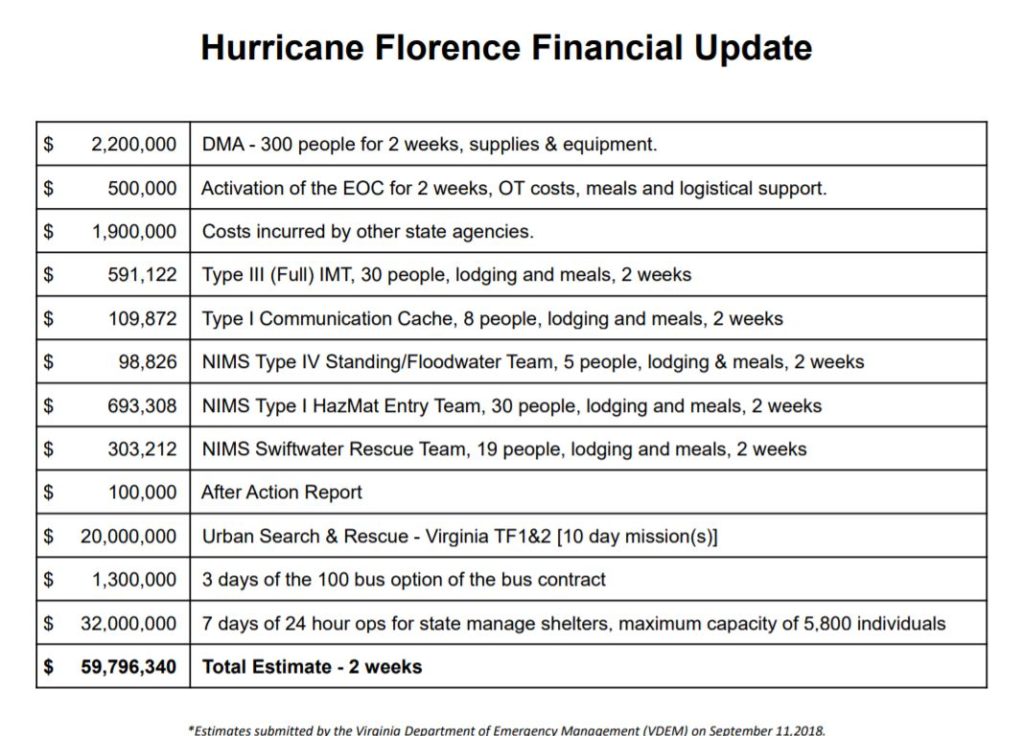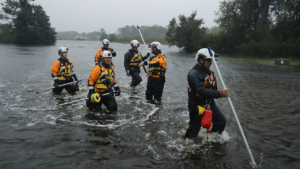
On Monday, Secretary of Finance Aubrey Layne talked about the cost of Virginia’s response to Hurricane Florence with little controversy, and that was before the storm spawned a series of tornadoes striking Mecklenburg County and Metro Richmond.
Thursday, after Florence visited Virginia directly, he made the same presentation to another committee and suddenly ran into major push back. “Shocking” was the word used by Senator Ryan McDougle, R-Hanover, who then admitted he was engaging in “Thursday morning quarterbacking.”
Under authority granted in state law and the budget, Governor Ralph Northam declared an emergency in Virginia on September 11 and authorized the expenditure of up to $60 million from state funds. He ordered an emergency evacuation in certain lowlands. Because his order followed a similar federal declaration, Virginia stands to recover up to 75 percent of the expense from federal funds, but only on a reimbursement basis up to two years from now.
Layne, who is known for loving to provide the details, added a chart listing the various plan elements and their authorized cost, reproduced above. Given the worst predictions didn’t come to pass for Virginia, only some of the funds were spent and the final accounting is not yet made.
It was some of those line items that generated the commentary in the Senate Finance Committee, especially three emergency shelters for 5,800 people at a possible cost of $32 million. Simple math pegs that at $788 per person per day, for shelter in state-owned buildings, not hotels. Questions also arose about $20 million authorized for two Virginia-based specialized rescue teams, based on a planned 10-day deployment, and other line items that appeared to include very generous amounts for food and lodging.
“Where in the world are they sleeping and what are they eating?” asked Sen. Richard Stuart, R-Westmoreland. “Somebody is gouging us.”
Layne promised to follow up with itemized costs and promised that auditors would be going over the expenses later. He repeated that what was authorized was not the same as what got spent, and the lump sum amounts for some of those teams probably included pay, transportation and other expenses beyond food and lodging. Some of them were dispatched to North Carolina instead when it became clear Virginia was out of the bulls-eye.

Which prompted yet another question from McDougle about whether North Carolina ever does the same and provides help when Virginia needs it. Layne was firm in responding to that, saying during his time as Secretary of Transportation he knew of times when North Carolina helped Virginia and he thought the Department of Emergency Management could provide other instances. Senator Bill Carrico, R-Galax, a former police officer, chimed in with some examples from his part of the state. Nobody else questioned the Governor’s decision to offer help to our neighboring state.
“If we had had the devastation we all expected, we wouldn’t be questioning this,” said Senator Rosalyn Dance, D-Petersburg. And one of her fellow Democrats, Janet Howell of Fairfax, went to climate change and how “these storms are coming at us at a frightening rate” and the federal government needs to “work on the models.”
Virginia’s response to this threat was far more robust than previous examples, as further data from Layne showed. He listed 26 “events” going back to 2010, including other hurricanes, with a total emergency response authorization of only $71 million. The big differences came from the early decision to mandate evacuations (with more that could have followed) and to open those three major shelters. Some of the expenses were made as emergency purchases outside the state’s normal procurement.
There might be an element of damned if you do or if you don’t in this. It was a badly-needed reality check and drill, with some lessons to be applied next time, because there will be a next time and we can all see what the Carolinas are now having to endure. Governor, Mr. Secretary, send them anything they ask for and we’ll worry about payment later.
Follow up: Details added in the Richmond Times-Dispatch story sparked by the same meeting. The reporter got to see the invoice for the shelter contract.

Leave a Reply
You must be logged in to post a comment.